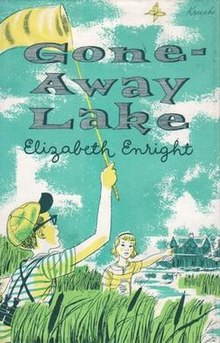Gone-Away Lake
 First edition cover with Krush artwork | |
| Author | Elizabeth Enright |
|---|---|
| Illustrator | Beth and Joe Krush |
| Cover artist | Krush |
| Genre | Children's novel |
| Publisher | Harcourt, Brace & Co. |
Publication date | 1957 |
| Publication place | United States |
| Media type | Print (hardcover, paperback), audiobook |
| Pages | 192 pp.[1] |
| OCLC | 42736382 |
| LC Class | PZ7.E724 Go[1] |
| Followed by | Return to Gone-Away |
Gone-Away Lake is a children's novel written by Elizabeth Enright, illustrated by Beth and Joe Krush, and published by Harcourt in 1957. It was a runner-up for the annual Newbery Medal and was named to the Lewis Carroll Shelf Award list in 1970. It tells the story of cousins who spend a summer exploring and discover a lost lake and the two people who still live there.
Enright, the Krushes, and Harcourt produced a sequel published in 1961, Return to Gone-Away, in which the children's family buys a house near Gone-Away.
Plot summary
Gone-Away Lake opens on a train traveling through the countryside of western New York state. Ten-year-old Portia Blake and her six-year-old brother Foster are going to see their favorite cousin, enthusiastic amateur naturalist Julian Jarman. The Jarmans have recently purchased a house in the country. Once there, Portia and Julian spend their days exploring, and one day they discover an abandoned Victorian resort community next to a bog. Elderly siblings Mr. Payton and Mrs. Cheever, the town's only remaining inhabitants, soon become friends with the children, who set up a club in one of the empty houses.
Stories of the days when the bog was a lake called Tarrigo are interspersed with the modern-day adventures of Portia and Julian, who at first keep the lake and their new friends a secret. Foster soon discovers the secret and eventually the rest of the Jarman and Blake families also become acquainted with the charms of Gone-Away and its inhabitants. In Return to Gone-Away, a sequel published in 1961, the Blake family buys and restores a house at Gone-Away.
Reception
Gone-Away Lake was a runner-up for the Newbery Medal in 1958 (now called a Newbery Honor Book).[2] It received the New York Herald Tribune's Children's Spring Book Festival Award in 1957.[3] In 1963 the American Library Association named Gone-Away Lake as the U.S. nominee for the international Hans Christian Andersen Award.[citation needed] It was named to the Lewis Carroll Shelf Award list in 1970.[4]
Reviewers then and now praise Enright's excellent characterization, her use of description, and strong presentation of setting and nature in Gone-Away Lake. A review by Irene Haas mentioned that "animals abound, and secrets and clubs, danger and daring".[5] According to Saturday Review, Enright "knows how to create real children".[3] Writer and reviewer Anita Silvey calls Gone-Away Lake "Enright's finest achievement" and praises "her descriptive powers and unique ability to observe the world through the eyes of a child".[6] Children's book expert May Hill Arbuthnot also praised Enright's fine use of description and observed, "Good prose style for any age level surprises and delights."[7]
In 2012 Gone-Away Lake was ranked number 42 among all-time best children's novels in a survey published by School Library Journal – the first of three books by Enright in the top 100.[8]
See also
References
- ^ a b "Gone-Away Lake". LC Online Catalog. Library of COngress (lccn.loc.gov). Retrieved 2015-10-31.
- ^ "Newbery Awards". Retrieved 2012-05-15.
- ^ a b Charlip, Remy (July 20, 1957). "Books for Young People". Saturday Review. p. 39. Retrieved 2012-05-15.
- ^ "Book awards: Lewis Carroll Shelf Award". LibraryThing.com. Retrieved 2012-02-05.
- ^ Chevalier, Tracy, ed. (1989), Twentieth-Century Children's Writers, St. James Press, p. 318.
- ^ Silvey, Anita (2002), The Essential Guide to Children's Books and Their Creators, Houghton Mifflin, p. 143.
- ^ Arbuthnot, May Hill (1964), Children and Books, Scott, Foresman, p. 19.
- ^ Bird, Elizabeth (July 7, 2012). "Top 100 Chapter Book Poll Results". A Fuse #8 Production. Blog. School Library Journal (blog.schoollibraryjournal.com). Retrieved 2015-10-31.
{{cite web}}: Italic or bold markup not allowed in:|publisher=(help)
External links
- Top 100 Children's Novels #65–61 (2010) – Gone-Away Lake covered as number 63 (ranked number 42 by an improved survey in 2012, see above)
